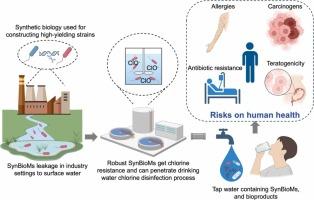Potential Biosafety Risks of Synthetic Biology Microorganism Leakage in Industry Settings to Drinking Water: A Review
IF 11.3
1区 环境科学与生态学
Q1 ENGINEERING, ENVIRONMENTAL
引用次数: 0
Abstract
The rapid development of synthetic biology has brought enormous economic benefits. Synthetic biology enterprises are globally distributed, with major hubs in the United States, Europe and China. The purpose of synthetic biology is to construct higher-yielding strains. Many well-characterized synthetic biology chassis are widely used in metabolic engineering and scaled for industrial production. However, high-concentration bioproducts exhibit microbial toxicity during production, inhibiting microbial growth and reducing productivity. To increase yields and titers, synthetic biology has been widely applied to enhance microbial tolerance to bioproducts through membrane engineering, stress response engineering and transcription factor engineering. However, like many emerging innovations, opportunities coexist with neglected risks. Synthetic biology microorganisms (SynBioMs) can enter natural water environments via wastewater discharge. Molecular engineering methods enhancing microbial tolerance to bioproducts may concurrently increase disinfectant resistance and enable evasion of water treatment processes, posing threats to drinking water biosafety. What’s more, the leaked industrial high-yield SynBioMs may exploit limited carbon sources in drinking water to produce bioproducts. Researchers are actively developing biocontainment strategies to prevent their dispersal in natural ecosystems, such as auxotrophy and genetic circuits. However, there are no relevant regulations mandating the addition of containment strategies for SynBioMs. Efforts to advance the synthetic biology economy and the development of leakage control strategies must proceed in tandem.

工业环境下合成生物微生物泄漏对饮用水的潜在生物安全风险综述
合成生物学的迅速发展带来了巨大的经济效益。合成生物学企业分布全球,主要集中在美国、欧洲和中国。合成生物学的目的是构建高产菌株。许多具有良好表征的合成生物学底盘被广泛应用于代谢工程和规模化工业生产。然而,高浓度的生物制品在生产过程中表现出微生物毒性,抑制微生物生长并降低生产率。为了提高产量和滴度,合成生物学已被广泛应用于通过膜工程、应激反应工程和转录因子工程来增强微生物对生物制品的耐受性。然而,与许多新兴创新一样,机遇与被忽视的风险并存。合成生物微生物(SynBioMs)可以通过废水排放进入自然水环境。提高微生物对生物制品耐受性的分子工程方法可能同时增加对消毒剂的耐药性,并使水处理过程得以逃避,对饮用水生物安全构成威胁。更重要的是,泄漏的工业高产synbiom可能会利用饮用水中有限的碳源来生产生物产品。研究人员正在积极开发生物控制策略,以防止它们在自然生态系统中扩散,例如营养不良和遗传回路。然而,没有相关法规强制要求为合成生物添加遏制策略。推进合成生物学经济的努力和泄漏控制策略的发展必须同步进行。
本文章由计算机程序翻译,如有差异,请以英文原文为准。
求助全文
约1分钟内获得全文
求助全文
来源期刊

Journal of Hazardous Materials
工程技术-工程:环境
CiteScore
25.40
自引率
5.90%
发文量
3059
审稿时长
58 days
期刊介绍:
The Journal of Hazardous Materials serves as a global platform for promoting cutting-edge research in the field of Environmental Science and Engineering. Our publication features a wide range of articles, including full-length research papers, review articles, and perspectives, with the aim of enhancing our understanding of the dangers and risks associated with various materials concerning public health and the environment. It is important to note that the term "environmental contaminants" refers specifically to substances that pose hazardous effects through contamination, while excluding those that do not have such impacts on the environment or human health. Moreover, we emphasize the distinction between wastes and hazardous materials in order to provide further clarity on the scope of the journal. We have a keen interest in exploring specific compounds and microbial agents that have adverse effects on the environment.
 求助内容:
求助内容: 应助结果提醒方式:
应助结果提醒方式:


